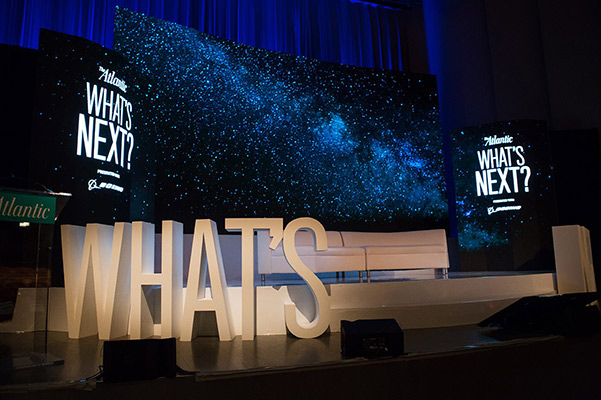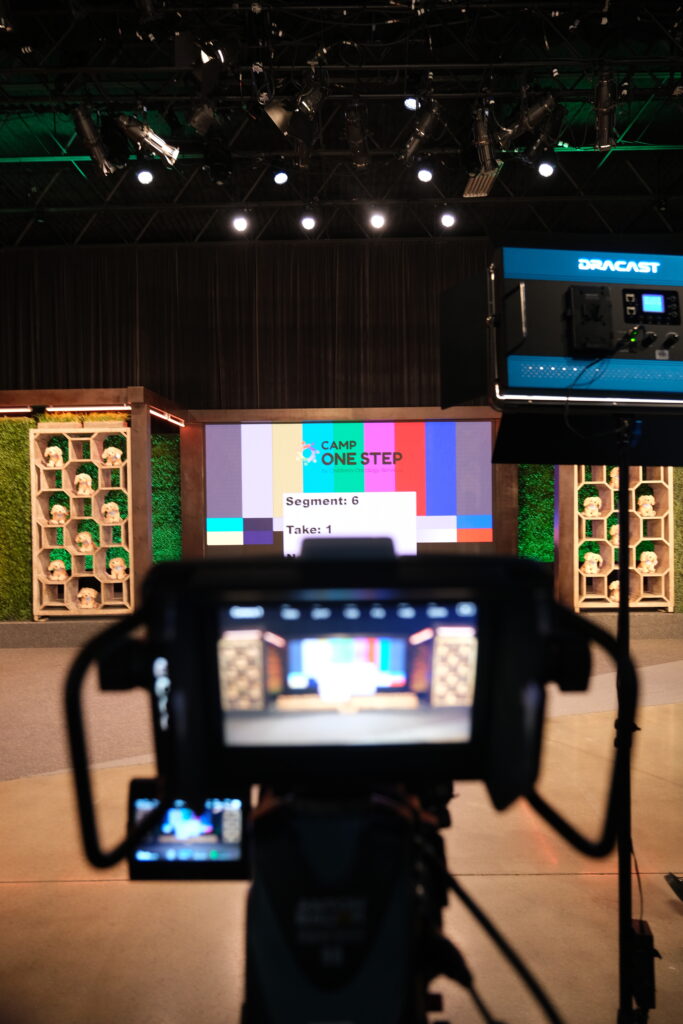You are the expert on your own business strategy, but how can you weave it into the fabric of your event? Events with brand-alignment and a purpose add exponential value and depth to your business and relationships. Let’s talk about how and why it works.
The Goal. The Strategy. The Tactics.
You know what your goal is; be it growth, education, outreach, celebration, or something else entirely, the way your event is built should reflect and support your goal. But do you have your strategy locked down? Knowing what tactics your organization is already employing to meet your goals will facilitate a harmonious event.
Your company would like to increase profits by driving sales of a new product with an ad campaign based around a live streamed launch event.
The goal is to increase profits.
The strategy is increasing sales of a new product.
The tactic is the ad campaign and the launch event.
This is a simple example but knowing the difference between the goal and the strategy can make a substantial difference to what success will look like for your event. Do you want to put the greater part of your budget towards a pop-up shop featuring your whole collection? Or would those funds be better spent creating a stockpile of marketing content for the new product? You see, the goal is at the center of everything, but the strategies you already employ to meet that goal are what must drive your event strategy. By meshing our human centric approach with your existing business strategy, we can work out the tactics to create the event that will return the most value.
Как играть в Fresh казино на рубли для россиян
Вы уже слышали о Fresh казино, но не знаете, как начать играть на реальные рубли? В этой статье мы расскажем вам все, что вам нужно знать о том, как играть в Fresh казино на рубли для россиян. Независимо от того, являетесь ли вы новичком или опытным игроком, у нас есть полезные советы и стратегии, которые помогут вам насладиться азартом и увеличить свои шансы на выигрыш.
Мы рассмотрим различные аспекты игры в Fresh казино на реальные рубли, включая регистрацию, пополнение счета, выбор игр и стратегии. Вы узнаете, как выбрать надежное казино, какие игры наиболее выгодные, и как использовать бонусы и акции для увеличения своих выигрышей. Готовы окунуться в мир азарта и возможностей? Прочитайте дальше и откройте для себя, как играть в Fresh казино на рубли для россиян и получить максимальное удовольствие от игры!
Основные правила игры в Fresh казино на рубли для россиян
Игра в онлайн-казино freshcasino247.com на рубли доступна для всех жителей России. Для начала игры вам необходимо зарегистрироваться на официальном сайте казино по адресу FreshCasino247.com. После регистрации вы получите доступ к широкому выбору азартных игр, включая слоты, рулетку, блэкджек и многое другое. В FreshCasino247.com вы можете играть как на деньги, так и в демонстрационном режиме, чтобы попробовать игры бесплатно перед тем, как делать реальные ставки. Казино предлагает различные способы пополнения и вывода денег, в том числе рубли, что делает игру еще более удобной для российских игроков.
На сайте FreshCasino247.com вы также найдете бонусные программы, акции и турниры, которые позволят вам увеличить свои выигрыши и получить дополнительные вознаграждения. Казино предлагает высокую степень безопасности и надежности, чтобы вы могли наслаждаться игрой, не беспокоясь о сохранности ваших данных и средств. FreshCasino247.com доступно на различных устройствах, включая компьютеры, смартфоны и планшеты, что позволяет играть в любое удобное для вас время и в любом месте. Присоединяйтесь к FreshCasino247.com и испытайте удовольствие от игры в онлайн-казино на рубли для россиян.
Преимущества игры в Fresh казино на рубли для россиян
Для российских игроков, Fresh казино предлагает возможность играть на рубли, что делает процесс еще более удобным и доступным. Чтобы начать игру в Fresh казино на рубли, необходимо выполнить несколько простых шагов. В первую очередь, нужно зарегистрироваться на официальном сайте казино. Для этого необходимо заполнить регистрационную форму, указав свои личные данные.
После успешной регистрации и входа в личный кабинет, российские игроки могут пополнить свой игровой счет в Fresh казино на рубли. Для этого казино предлагает различные способы пополнения, включая банковские карты, электронные кошельки и другие платежные системы. После выбора удобного способа пополнения, нужно указать сумму и следовать инструкциям на экране.
Когда игровой счет пополнен, российские игроки могут начать играть в Fresh казино на рубли. Казино предлагает широкий выбор азартных игр, включая слоты, рулетку, блэкджек и другие популярные игры. Для начала игры, нужно выбрать желаемую игру из каталога, указать ставку и запустить игровой процесс. Fresh казино обеспечивает честность игры и высокую степень безопасности, чтобы российские игроки могли насладиться азартом без каких-либо забот.
Советы и стратегии для успешной игры в Fresh казино на рубли для россиян
Игра в казино является популярным развлечением для многих россиян, и Fresh казино предлагает уникальную возможность играть на рубли. Для того чтобы начать играть, необходимо зарегистрироваться на официальном сайте казино. Для регистрации потребуется указать личные данные, создать учетную запись и выбрать удобный способ пополнения счета.
После успешной регистрации и пополнения счета, можно начинать играть в Fresh казино на рубли. Казино предлагает широкий выбор игровых автоматов, настольных игр, рулеток и многих других азартных развлечений. Каждая игра имеет свои правила и стратегии, поэтому перед началом игры рекомендуется ознакомиться с правилами и особенностями каждой игры.
В Fresh казино на рубли для россиян предусмотрены различные бонусы и акции. Новые игроки могут получить приветственный бонус, который увеличит их первый депозит. Кроме того, казино регулярно проводит акции, розыгрыши призов и другие специальные предложения. Чтобы не упустить возможность получить дополнительные бонусы, рекомендуется подписаться на рассылку казино или следить за новостями на официальном сайте.
Игра в Fresh казино на рубли предоставляет возможность не только получить удовольствие от азартных развлечений, но и выиграть реальные деньги. Однако важно помнить, что азартные игры могут вызывать зависимость, поэтому рекомендуется играть ответственно, устанавливать лимиты на депозиты и время игры. Fresh казино также предлагает возможность самоограничения и самовыключения, чтобы игроки могли контролировать свою активность в казино.
Бонусы и акции в Fresh казино на рубли для россиян
Игра в казино Fresh на рубли для россиян – это простой и увлекательный способ испытать свою удачу и получить шанс на крупный выигрыш. Чтобы начать игру, вам необходимо зарегистрироваться на официальном сайте казино Fresh. После регистрации вы сможете пополнить свой счет в рублях и выбрать из множества азартных игр, доступных на платформе.
В Fresh казино вы найдете разнообразные слоты, рулетки, покер, блэкджек и другие популярные игры. Каждая игра имеет свои правила и стратегии, поэтому перед началом игры рекомендуется ознакомиться с их описанием. Также казино предлагает различные бонусы и акции, которые могут увеличить ваши шансы на победу.
В Fresh казино вы можете играть на рубли, что делает игру более удобной и доступной для российских игроков. Пополнение и вывод средств осуществляются через популярные платежные системы, такие как Яндекс.Деньги и WebMoney. Казино также гарантирует безопасность ваших финансовых операций и конфиденциальность ваших данных, что делает игру в Fresh казино надежной и безопасной.
Безопасность и надежность игры в Fresh казино на рубли для россиян
Для российских игроков, играющих в Fresh казино на рубли, доступно множество вариантов развлечений. Вам необходимо создать аккаунт на официальном сайте казино, чтобы начать играть. После успешной регистрации вы можете пополнить свой счет, используя различные платежные системы, такие как банковские карты, электронные кошельки или банковский перевод. После пополнения счета вы можете выбрать любую игру из огромного ассортимента, представленного на сайте Fresh казино. Вам доступны слоты, рулетка, покер, блэкджек и многое другое. Выберите игру, которая вам нравится, и начинайте играть на реальные деньги. Удачи вам!
Важно помнить, что при игре в Fresh казино на рубли необходимо следить за своим банкроллом и установить пределы для себя. Установите лимиты на депозиты и ставки, чтобы не превысить свои финансовые возможности. Также не забывайте о правилах ответственной игры и не играйте под влиянием алкоголя или наркотических веществ. Fresh казино предлагает безопасную и защищенную игровую платформу, где вы можете наслаждаться азартом и возможностью выигрыша настоящих денег. Приятной игры!
В заключение, игра в Fresh казино на рубли является прекрасной возможностью для российских игроков насладиться захватывающими азартными играми и выиграть реальные деньги. Благодаря широкому выбору игр, удобному интерфейсу и безопасным платежным методам, Fresh казино предлагает незабываемый игровой опыт. Кроме того, регулярные бонусы и акции делают игру еще более привлекательной. Не упустите возможность испытать удачу в Fresh казино и погрузиться в захватывающий мир азартных игр прямо сейчас!
You bring the strategy. We will build the tactics
What should your event planners handle, and what should they not? What do you feel comfortable driving and creating? What do you need guidance on? A good event planner is talented at bringing your vision to life. They take your big picture and break it down into the individual tasks, using your strategy as a blueprint. In other words, your planner is responsible for the “How,” and you are in charge of the “Why”. You may be ready to go with exactly what you think your event should look like. Or you may be feeling a bit lost and confused. Before you jump into the tactics be prepared to talk about goals and the strategic decisions that lead you to planning an event in the first place.
Brainstorming for Success
How do I apply my business strategy to my event plan? What decisions will my strategy affect? Finding out where your strategy will manifest unique tactics, requires some thought and teamwork. Brainstorming. The word conjures images of word webs, colorful charts, and post-it notes on a whiteboard. Often brainstorming is best when the goal is not producing ideas, instead the simple process of organized thinking in a group setting with simple goals in mind will form a mutual understanding of the goal and strategy, decide on the requisite pieces of the event, and how you want your guests to feel at each point. You will provide your planner with information about your audience, and ideas about achieving your goals will come naturally. Below, we share some of our most effective brainstorming activities for this phase of planning.
The Activity: Persona Building
How it Works: For each subset of your audience, you will gather pertinent information to better understand how that person will react to the choices we make. This should include demographics, needs, wants, goals, values, and anything else that may influence that person’s state of mind as they experience what we create. We may go through this for the whole audience, or break it down further (ex. At a graduation you may consider parents, students, and teachers separately as the ceremony means vastly different things to each group)
How it informs Strategy: It brings the audience experience into the spotlight. Often information discovered in this way will highlight the value in options you would otherwise not consider. (For a corporate event you may note that many of your employees have small children. To create an environment where these parents can relax, you may consider a more family inclusive direction. or a daycare option)
The Activity: Projecting Success, Questioning Roadblocks
How it Works: You will imagine how you feel the day after your event and describe what success will feel like in that moment. You will also explore what the opposite might look like.
How it informs Strategy: Having your hopes out on the table ensures that they can be honored. And addressing your fears from the get-go leaves plenty of time to plan around perceived obstacles. (It may not otherwise come up that you would be embarrassed to lose track of your speech during your presentation. But with time to plan we can ensure we have a teleprompter ready with your speech and that we allot extra rehearsal time to ensure your comfort.)
The Activity: Ask “Why?”
How it Works: You will start with a goal or fear (Maybe one discovered in the “Projecting Success, Questioning Roadblocks” activity?) and write it down. Then release your inner toddler and “Why?” repeatedly until you reach the core intention. For example:
We worry people will not engage with the chat feature built into our program.
Why?
They will not think to look for it or will not know how to use it.
Why?
There is not a good way to explain it to them before the program.
This last statement provides clearly defined challenge with achievable solutions. Audience connection before the event, an easy-to-use chat feature, and a more noticeable icon will all alleviate pressures described in each of the statements. And it becomes easy to see the solution, where as further up the activity the more abstract statements may not have straightforward answers. Good brainstorming will have this dynamic, of simplifying the problem and clarifying solutions, without putting people on the spot in solving abstract and subjective worries.
How it informs Strategy: Getting to the bottom of your goals and challenges will illuminate the path forward, naturally suggesting solutions. And bridging the gap between problem and solution.
These activities are geared towards fostering a better understanding of the challenges at hand. Not every planning process will lend itself to these activities. Your planner will have these and others in their toolkit and will be able to choose activities that best facilitate your unique event. Once they fully understand the challenge a discussion about strategy will come into play.
Working with Humans, for Humans
How does your strategy translate to an event? Once everyone at the table has a strong understanding of the goal and path it is time to talk tactics. Like most things in the world of events, it comes back to people. Knowing your target audience is only step one. You must be able to anticipate how they will react to the choices you will make throughout the process. As you move out of the strategy phase and into the planning phase it is important to keep the discoveries of your brainstorming fresh in your mind. They are not touchpoints to discuss then move away from, they should be the guiding star of your complete process.
If you developed personas for your audience, bring them back out when you start talking about streaming platforms. A group of teachers may find Zoom reminds them of the frustrations of teaching virtually. This could raise their stress levels, putting them in a contentious mood, where a message from the administration will be less likely to be received positively.
If, in your roadblocks discovery you stated that your speaker, a Holocaust Survivor, might decide last minute that it is unsafe to come into the studio for the broadcast. Then it becomes important to create a contingency plan that supports the speaker’s needs for safety and technical support.
If you took a deep dive into the “Why?” of your product launch, your conclusions will often directly translate to actionable steps.
We will take a deep dive into the tactics that come out of strategy in another post. But for now, take some time to think define your strategy for yourself and be ready to ask, “Why?” in your next event planning meeting.
Tags: brainstorming, brand, planning, virtual events



